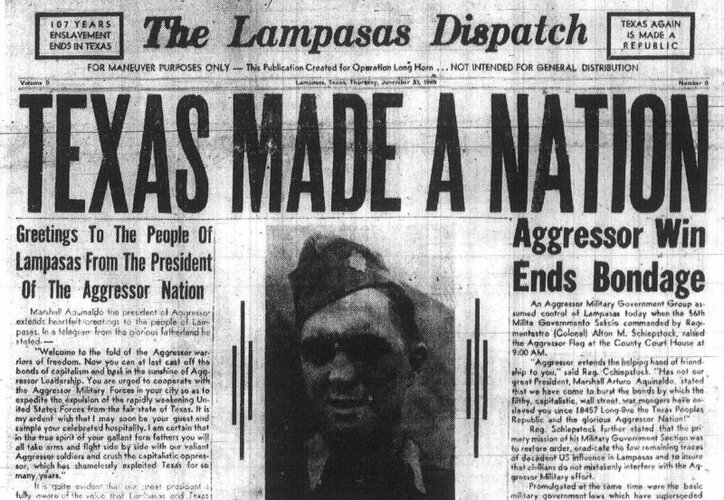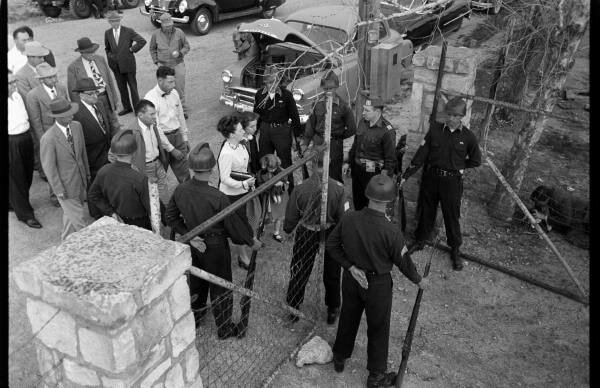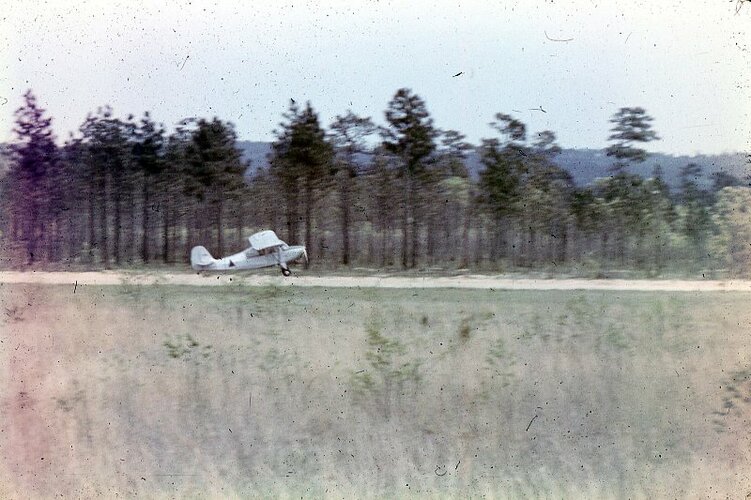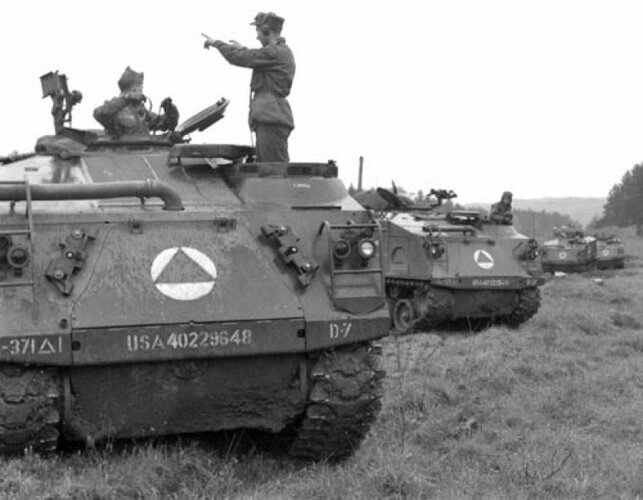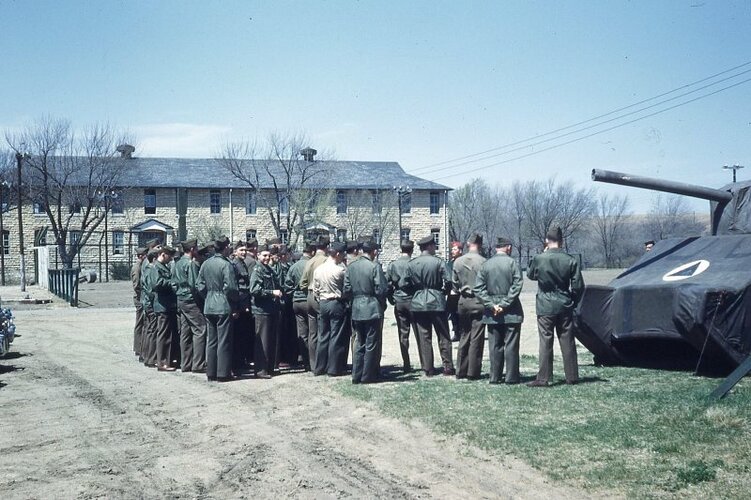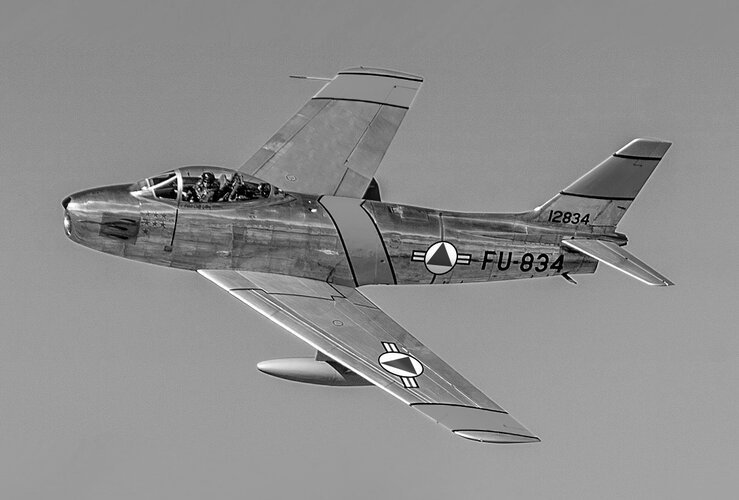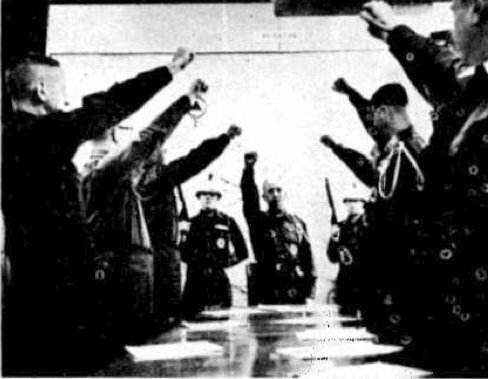The story goes like this (US Army description):
At the close of World War II in 1945 the chaotic conditions in Western Europe, resulting from fundamental disagreements between the victorious allied nations, gave rise to a new nation, Aggressor.
When the surrender of Germany was followed almost immediately by wholesale allied withdrawals, a small group of determined men, confirmed in their belief in the totalitarian state, established a Fascist type of organization called the Circle Trigon Party. That this action succeeded was due primarily to a disinclination on the part of any one nation to accept the responsibility for the direct physical action necessary to suppress this new group, and to the clever use of propaganda and slogans by the Circle Trigonists who freely used the terms "democracy," "the people," and other similar terms. As soon as the Party had consolidated its position in Bavaria it began to infiltrate adjacent regions. It found a fertile field for its well-planned and executed propaganda in Spain, southern France, northern Italy, and the Tyrol, which joined in the formation of the Aggressor nation late in 1945. A brutal political police system soon silenced all opposition. By early 1946 a triumvirate of three men, popularly known as "the Trinity," gained absolute control of the Circle Trigon Party and of the Aggressor nation.
Immediately upon its establishment, Aggressor entered upon a well-balanced and carefully controlled period of intense development and organization of all resources and phases of national life; quickly gaining the immediate goal of national unity and relative self-sufficiency. In contrast to its neighbors, Aggressor was reasonably prosperous and its people happy and contented with the new government as it started to fulfill its initial promises. One advantage enjoyed by the new nation was that the bulk of its lands had escaped the destruction of war which had so severely impaired the national economy of other European nations. Aggressor was in a peculiar position in the world, as her able leaders had foreseen. Initially backed in secret by both the eastern and the western powers, Aggressor was alarmed at the closer and closer friendly relations between the Soviet Union, the United Kingdom, and the United States, and feared united action on the part of these powers. Engaged in a race against time, she must be well established before the dull and war-weary former allies realized her true ambition and organized to put her down. Her leaders believed that she must strike before that day and the blow must be against her most powerful opponent, the United States.
Turning its attention from the devastated areas of Western Europe to the prosperous and unscathed lands of North America, Aggressor began plans in early 1946 for an invasion of the United States. Although the United States had emerged from the war as a strong military nation, its hasty and ill-advised demobilization, together with widespread internal disturbance and general war-weariness, convinced the Aggressor High Command that such a plan offered a reasonable chance of success if aided by a well-organized branch of the Circle Trigon Party within the United States, and by a skillful propaganda campaign.
In late 1946, Aggressor, aided by agents and sympathizers, seized the Antilles chain of islands and the Panama Canal.
In November an Aggressor expedition then passed through the Canal and landed on the coast of California. As the Aggressor Navy was inadequate to protect the supply line, the Aggressor troops were defeated. Quisling groups in the United States, however, assisted in arranging a peace in which Aggressor retained bases in the Caribbean area. Aggressor's determination to conquer the North American continent next resulted in a second campaign in the fall of 1947. The Aggressor Third Army overran portions of North Carolina, South Carolina, Georgia, and Florida in a large scale amphibious assault on the southeastern coast of the United States. After suffering a serious defeat this Aggressor force began an evacuation of troops while making a final stand in the Florida area. The Aggressor units which could not be evacuated were annihilated. However, individual soldiers, aided by Aggressor sympathizers, scattered over the entire United States and became members of and advisers to subversive groups.
In the meantime, Aggressor launched a combined amphibious and airborne invasion across the North Atlantic Ocean. By the winter of 1947 Aggressor held all of New England and the St. Lawrence River area, and had driven a wedge southwest through New York State to the general line BUFFALO-SCRANTON-ALBANY-NEW HAVEN.
As the Aggressor nation continued to build up its military strength in the Caribbean, emphasis was placed on preparation and training for airborne operations. Meanwhile, subversive organizations of Aggressor sympathizers in the United States grew in size and number. The tempo of subversive incidents increased. The climax of the subversive movement was an open attack in the Tennessee-Kentucky area by a subversive organization known as the Green Brigade. The attack began in April of 1948 as a series of raids on the supplies and arms stored at Fort Campbell, Kentucky. The Green Brigade then captured the airfield and laid siege to the camp. As the United States launched an attack against these guerrilla forces, Aggressor Forces from the Caribbean executed a successful airborne landing in Tennessee. The United States Air Force succeeded in disrupting continued Aggressor air action and blocked the follow up air lift. The Aggressor airborne force was then annihilated and members of the Green Brigade immediately disappeared. The Circle Trigon Party again went underground. See figure 2 for Aggressor campaigns in the United States.
Concerned over the stubborn Aggressor defense of New England, and over the critical United States shipping losses in the Atlantic, the United States decided upon a limited attack against Aggressor Caribbean installations in the early spring of 1949. On 2 March, joint amphibious United States forces landed on the Island of Vieques, destroyed midget submarine pens there and at San Juan, Puerto Rico, and withdrew according to plan, after the successful completion of their mission. Immediately following this attack. Aggressor propagandists made much of the limited objective and rapid withdrawal of United States forces.
As if in retaliation for the assault against Puerto Rico, Aggressor Caribbean forces executed an airborne invasion of the United States early in May 1949. The initial attack, preceded by general labor unrest and industrial sabotage throughout South-eastern United States, resulted in Aggressor seizure of Pope Air Force Base and the Fort Bragg (North Carolina) area. The United States Air Force soon gained air superiority but not until Aggessor had air-landed an entire corps. United States forces attacked at once, brought up reinforcements, and by mid-June had killed or captured the entire Aggressor force with the exception of the most important commanders and one elite regiment. Late in May 1949, when the Aggressor High Command realized that the Carolina campaign was doomed to failure, part of a large convoy—ostensibly en route to the Caribbean—broke off in mid-Atlantic, rounded Cape Horn, and headed for the Hawaiian Islands. Secrecy was maintained by a screen of submarines and carrier-based planes which destroyed approaching ships and aircraft without a trace. The small U. S. garrison and hastily-mobilized National Guard units put up stubborn resistance, chiefly on Oahu, but by 19 June Aggressor was in control of the entire archipelago. The United States immediately organized a joint amphibious western task force. This task force assaulted Oahu on 25 October and completely recaptured the islands by mid-November. Only a few submarines and key command personnel escaped destruction in an attempted last-minute, Aggressor evacuation.
The Aggressor High Command had realized for a long time that Alaska was one of the gateways to the United States, and that, while the Hawaiian Islands were in possession of Aggressor, a route was open to invade Alaska. Hence plans were made, and appropriate supplies were stockpiled on the island of Hawaii for an amphibious operation against Alaska. No definite date had been set for the operation, but when the United States counter-invasion plans of Hawaii became known, Aggressor decided that an Alaskan invasion would serve as a counterstroke that would render the northern flank of the United States vulnerable. On 4 October 1949, Aggressor Task force "Schnee" departed from Hilo, and made an amphibious landing in the vicinity of Anchorage, Alaska. By mid-February Aggressor units had advanced beyond Northway.
Taking advantage of interior lines of communications, United States forces again mounted a major raid on the island of Vieques lying just east of the Aggressor stronghold of Puerto Rico. Defensive forces were quickly overrun and the submarine base installations, which had been repaired after the raid of March 1949, were again demolished.
As if in retaliation Aggressor mounted an airborne attack on the Fort Bragg, North Carolina area. United States Air Forces reacted swiftly, secured air superiority and cut in on the Aggressor aerial line of communication. A counterattack of two airborne divisions with strong aerial support quickly destroyed the invading forces which could no longer be supplied.

